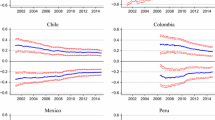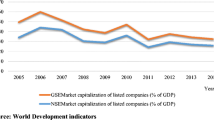Abstract
This study examines the presence of the “month of the year effect” in the six emerging Asian stock markets (India, Indonesia, Japan, Malaysia, Philippines, and South Korea) for the period January, 1991 to November, 2020 using GARCH (1, 1), EGARCH (1, 1) and TGARCH (1, 1) models. The empirical results indicate the existence of “month of the year effects” on stock returns and volatility of all the emerging Asian stock markets except Japan. The study reveals a positive and significant January effect for each country except Japan. February, April and July effects are positive and significant only in the case of Indonesia, South Korea and Malaysia respectively. The findings confirm the persistence of ARCH and GARCH effects in the monthly return series. Moreover, the asymmetric GARCH models show that the emerging Asian stock market returns exhibit asymmetric (leverage) effect. The seasonal or monthly effect in stock markets in Emerging Asian countries poses an important research question as Emerging Asia’s economic footprint has been growing significantly. The findings of the study have important implications for active and profitable trading strategies.
Similar content being viewed by others
References
Ariel, R. A. (1987). A monthly effect in stock returns. Journal of Financial Economics, 18(1), 161–174
Ariel, R.A. (1990). High stock returns before holidays: Existence and evidence on possible causes. The Journal of Finance, 45(5), 1611–1626.
Athanassakos, G., & Schnabel, J. A. (1994). Professional portfolio managers and the January effect: theory and evidence. Review of Financial Economics, 4(1), 79–91
Beyer, S., Garcia-Feijoo, L., & Jensen, G. R. (2013). Can you capitalize on the turn-of-the-year effect? Applied Financial Economics, 23(18),1457–1468
Bildik, R. (2004). Are calendar anomalies still alive?: Evidence from Istanbul stock exchange. SSRN Electronic Journal. DOI:https://doi.org/10.2139/ssrn.598904
Black, F. (1976). Studies of stock price volatility changes, in: Proceedings of the 1976 Meeting of the Business and Economic Statistics Section. American Statistical Association, Washington DC., 177–181
Bohl, M. T., & Salm, C. A. (2010). The other January effect: International evidence. The European Journal of Finance, 16(2), 173–182
Bollerslev, T. (1986). Generalized autoregressive conditional heteroscedasticity. Journal of Econometrics, 31, 307–327
Cai, J., Li, Y., & Qi, Y. (2006). The day-of-the-week effect: New evidence from the Chinese stock market. Chinese Economy, 39(2), 71–88
Caporale, G. M., & Zakirova, V. (2017). Calendar anomalies in the Russian stock market. Russian Journal of Economics, 3, 101–108
Chatzitzisi, E., Fountas, S., & Panagiotidis, T. (2021). Another look at calendar anomalies. The Quarterly Review of Economics and Finance, 80, 823–840
Chiah, M., & Zhong, A. (2019). Day of the week in anomaly returns: International evidence. Economic Letters, 182(C), 90–92
Choudhary, K., & Choudhary, S. (2008). Day-of-the-week effect: Further empirical analysis. Asia Pacific Business Review, 4(3), 67–74
Choudhry, T. (2000). Day of the week effect in emerging Asian stock markets: Evidence from the GARCH model. Applied Financial Economics, 10(3), 235–242
Compton, W., Kunkel, R. A., & Kuhlemeyer, G. (2013). Calendar anomalies in Russian stocks and bonds. Managerial Finance, 39(12), 1138–1154
Cross, F. (1973). The behavior of stock prices on Fridays and Mondays. Financial Analysts Journal, 29(6), 67–69
Damodaran, A. (1989). The weekend effect in information releases: A study of earnings and dividend announcements. Review of Financial Studies, 2(4), 607–623
Diaconasau, D. E., Mehdian, S., & Stoica, O. (2012). An examination of the Calendar anomalies in the Romanian stock market. Emerging Markets Queries in Finance and Economics, 3, 817–822
Drimbetas, E., Sariannidis, N., & Porfiris, N. (2007). The effect of derivatives trading on volatility of the underlying asset: evidence from the Greek stock market. Applied Financial Economics, 17(2), 139–148
Dyl, E. A. (1977). Capital gains taxation and year-end stock market behavior. The Journal of Finance, 32(1), 165–175
Engle, R. F., & Ng, V. K. (1993). Measuring and testing the impact of news on volatility. Journal of Finance, 48(5), 1749–1778
Fabozzi, F. J., Ma, C. K., & Briley, J. E. (1994). Holiday trading in futures markets. The Journal of Finance, 49(1), 307–324
Floros, C., & Salvador, E. (2014). Calendar anomalies in cash and stock index futures: International evidence. Economic Modelling, 37(C), 216–223
Fountas, S., & Segredakis, K. N. (2002). Emerging stock markets return seasonality: The January effect and the tax-loss selling hypothesis. Applied Financial Economics, 12(4), 291–299
French, K. R. (1980). Stock returns and the weekend effect. Journal of Financial Economics, 8(1), 55–69
Gerlach, J. R. (2007). Macroeconomic news and stock market calendar and weather anomalies. The Journal of Financial Research, 30(2), 283–300
Gibbons, M. R., & Hess, P. (1981). Day of the week effects and asset returns. Journal of Business, 54(4), 579–596
Glosten, L. R., Jaganathan, R., & Runkle, D. E. (1993). On the relation between the expected value and the volatility of the nominal excess returns on stocks. Journal of Finance, 48(5), 1779–1801
Gultekin, M. N., & Gultekin, N. B. (1983). Stock market seasonality international evidence. Journal of Financial Economics, 12(4), 469–481
Harshita, H., Singh, S., & Yadav, S. S. (2018). Calendar anomaly: unique evidence from the Indian stock market. Journal of Advances in Management Research, 15(1), 87–108
Haug, M., & Hirschey, M. (2006). The January Effect. Financial Analysts Journal, 62(5), 78–88
Haugen, R., & Jorion, P. (1996). The January Effect: Still There after All These Years. Financial Analysts Journal, 52(1), 27–31
Jaffe, J., & Westerfield, R. (1985). Patterns in Japanese common stock returns: Day of the week and turn of the year effects. The Journal of Financial and Quantitative Analysis, 20(2), 261–272
Jaisinghani, D. (2016). An empirical test of calendar anomalies for the Indian securities markets. South Asian Journal of Global Business Research, 5(1), 53–84
Jaisinghani, D., Kaur, M., & Inamdar, M. M. (2020). Analyzing seasonal anomalies for Israel: evidence from pre- and post-global financial crisis. Managerial Finance, 46(3), 435–450
Jones, C. P., Pearce, D. K., & Wilson, J. W. (1987). Can tax-loss selling explain the January effect? A note. The Journal of Finance, 42(2), 453–461
Keim, D. B. (1983). Size-related anomalies and stock return seasonality: Further empirical Evidence. Journal of Financial Economics, 12(1), 13–32
Kumar, S. (2015). Turn of month effect in the Indian currency market. International Journal of Managerial Finance, 11(2), 232–243
Kunkel, R. A., Compton, W. S., & Beyer, S. (2003). The turn-of-the-month effect still lives: The international evidence. International Review of Financial Analysis, 12(2), 207–221
Kutchu, V. (2012). An Empirical study on day of the week effect in Indian stock market during different settlement regimes using GARCH framework. Indian Journal of Commerce and Management Studies, 3(3), 85–91
Lakonishok, J., & Smidt, S. (1988). Are seasonal anomalies real? A ninety-year perspective. The Review of Financial Studies, 1(4), 403–425
Lean, H. H., Smyth, R., & Wong, W. K. (2007). Revisiting calendar anomalies in Asian stock markets using a stochastic dominance approach. Journal of Multinational Financial Management, 17(2), 125–141
Lian, K. K., & Chen, W. Y. (2004). Seasonal anomalies of stocks in Asian equity market. Sunway College Journal, 1, 1–11
Lo, A. W. (2004). The adaptive markets hypothesis: Market efficiency from an evolutionary perspective. Journal of Portfolio Management, 30(5), 15–29
Maher, D. and Parikh, A. (2013). The turn of the month effect in India: A case of large institutional trading pattern as a source of higher liquidity. International Review of Financial Analysis, 28, 57–69
Narayan, P. K., Mishra, S., & Narayan, S. (2014). Spread determinants and the day-of-the week effect. The Quarterly Review of Economics and Finance, 54(1),51–60
Nelson, D. (1991). Conditional Heteroskedasticity in Asset Returns: A New Approach. Econometrica, 59, 347–370
Nicolosi, G., Peng, L., & Zhu, N. (2009). Do individual investors learn from their trading experience? Journal of Financial Markets, 12(2), 317–336
Ogden, J. P. (1990). Turn-of-month evaluations of liquid profits and stock returns: a common explanation for the monthly and January effects. The Journal of Finance, 45(4), 1259–1272
Olson, D., Mossman, C., & Chou, N. T. (2015). The evolution of the weekend effect in us markets. The Quarterly Review of Economics and Finance, 58(C), 56–63
Parikh, A. (2009). The December phenomenon: Month of the year effect in Indian stock market.NSE News,3–10. Available at SSRN: https://ssrn.com/abstract=1592046
Pandey, I. M. (2002). Is there seasonality in the Sensex monthly return? IIMA Working Papers, Indian Institute of Management Ahmedabad, Research and Publication Department
Plastun, A., Sibande, X., Gupta, R., & Wohar, M. E. (2019). Rise and fall of calendar anomalies over a century. North American Journal of Economics and Finance, 49, 181–205
Raj, M., & Kumari, D. (2006). Day-of-the-week and other market anomalies in the Indian stock market. International Journal of Emerging Markets, 1(3), 235–246
Reinganum, M. R. (1983). The anomalous stock market behavior of small firms in January: Empirical tests for tax-loss selling effects. Journal of Financial Economics, 12(1), 89–104
Roll, R. (1983). On computing mean returns and the small firm premium. Journal of Financial Economics, 12(3), 371–386
Rozeff, M. S., & Kinney, W. R. (1976). Capital market seasonality: The case of stock returns. Journal of Financial Economics, 3(4), 379–402
Sharma, S. S., & Narayan, P. K. (2012). Firm heterogeneity and calendar anomalies. Applied Financial Economics, 22(23), 1931–1949
Sharma, S. S., & Narayan, P. K. (2014). New evidence on turn-of-the-month effects. Journal of International Financial Markets, Institutions & Money, 29, 92–108
Sias, R. W., & Starks, L. T. (1995). The day-of-the-week anomaly: The role of institutional investors. Financial Analysts Journal, 51(3), 58–67
Sias, R. W., & Starks, L. T. (1997). Institutions and Individuals at the Turn of the Year. The Journal of Finance, 52(4), 1543–1562
Siddiqui, T. A., & Narula, I. (2013). Market efficiency and anomalies: Evidences from S&P CNX NIFTY. Vision: The Journal of Business Perspective, 17(3), 233–245
Sikes, S. A. (2014). The turn-of-the-year effect and tax-loss-selling by institutional investors. Journal of Accounting and Economics, 57(1), 22–42
Wuthisatian, R. (2021). An examination of calendar anomalies: Evidence from the Thai stock market. Journal of Economic Studies. https://doi.org/10.1108/JES-06-2020-0298
Zhang, J., Yongzeng L. and, & Jianghong, L. (2017). The day-of-the-Week effects of stock markets in different countries. Finance Research Letters, 20(C), 47–62
Funding
The authors received no financial support for the research, authorship and/or publication of this article.
Author information
Authors and Affiliations
Corresponding author
Ethics declarations
The authors declare no potential conflicts of interest with respect to the research, authorship and/or publication of this article.
Additional information
Publisher’s note
Springer Nature remains neutral with regard to jurisdictional claims in published maps and institutional affiliations.
Rights and permissions
About this article
Cite this article
Aggarwal, K., Jha, M.K. Stock returns seasonality in emerging asian markets. Asia-Pac Financ Markets 30, 109–130 (2023). https://doi.org/10.1007/s10690-022-09370-y
Received:
Revised:
Accepted:
Published:
Issue Date:
DOI: https://doi.org/10.1007/s10690-022-09370-y




